Home | Category: Sharks / Humans, Sharks and Shark Attacks
ENDANGERED SHARKS

Shark skin for sale Shark populations worldwide are under severe pressure from industrial fishing, with a third to two thirds of shark and ray species assessed by the International Union for the Conservation of Nature listed as threatened or near-threatened. Tens of millions of sharks are killed every year for their fins, which are used to make shark fin soup, an Asian delicacy (See shark finning and shark fin soup ). Many of these sharks are “finned” alive, then dumped back into the ocean to drown or bleed to death. Vessels fishing for tuna, swordfish and other species accidentally catch millions more annually. Recreational anglers help deplete shark populations as well, taking 200,000 annually off U.S. coasts, according to the National Marine Fisheries Service.
In 2021 the International Union for the Conservation of Nature (IUCN) said almost four in ten sharks and rays were threatened with extinction. A study based on wide variety of sources — including documents from universities, fish markets and fishing clubs as well as local sightings of sharks — by Dalhousie University in Halifax, Nova Scotia, Canada and Italian researcher Francesci Ferretti estimated that populations of mackerel shark, hammerhead shark, thresher shark and blue shark were down 99 percent in parts of Mediterranean and down by an average of around 80 percent to 95 percent in the sea as a whole. Ferretti said the Mediterranean is “very dangerous place for a shark. “He said one of reasons for the decline was that fishermen there were catching sharks for the shark fin market in Asia to compensate for declines in catches of traditional fish sources such as tuna and bony fish. Another Dalhousie University study based on records of fish caught on long lines worldwide found that between 1986 and 2000, the number of all shark species caught declined by at least 50 percent. Tiger shark populations were down 65 percent, great whites and threshers were down by 80 percent, oceanic whitetip by 70 percent and hammerhead dropped to an alarming 90 percent.
Sharks have reigned at the top of the ocean food chain for hundreds of millions of years. But, scientists say, they are particularly vulnerable to overfishing because they grow slowly, mature late and produce few offspring. Great White Sharks take about 15 years to reach reproducible age and have liters of no more than a few pups and breed only once in two years. "The classic fisheries management approach of 'fishing down' a given population to its so-called maximum sustainable yield, and then assuming it can recover, does not work for sharks," said Matt Rand, a shark expert at the Washington-based Pew Environment Group. Regional studies have shown that when shark populations crash the impact cascades down through the food chain, often in unpredictable and deleterious ways. [Source: AFP, November 22, 2010]
Related Articles: HISTORY OF HUMANS AND SHARKS: ANCIENT PEOPLE, ART AND WRITERS ioa.factsanddetails.com; SHARK PRODUCTS ioa.factsanddetails.com; SHARK FIN SOUP AND TRYING TO STOP CONSUMPTION OF IT ioa.factsanddetails.com; SHARK TOURISM AND SWIMMING WITH SHARKS ioa.factsanddetails.com ;SHARKS AND RAYS ioa.factsanddetails.com; HUMANS, SHARKS AND SHARK ATTACKS ioa.factsanddetails.com; SHARKS: CHARACTERISTICS, SENSES AND MOVEMENT ioa.factsanddetails.com ; SHARK BEHAVIOR: INTELLIGENCE, SLEEP AND WHERE THEY HANG OUT ioa.factsanddetails.com ; SHARK SEX: REPRODUCTION, DOUBLE PENISES, HYBRIDS AND VIRGIN BIRTH ioa.factsanddetails.com ; SHARK FEEDING: PREY, HUNTING TECHNIQUES AND FRENZIES ioa.factsanddetails.com ; HISTORY OF SHARKS: EARLIEST ONES. DINOSAUR-ERA ONES AND MEGALODON ioa.factsanddetails.com
Websites and Resources: Shark Foundation shark.swiss ; International Shark Attack Files, Florida Museum of Natural History, University of Florida floridamuseum.ufl.edu/shark-attacks ; Animal Diversity Web (ADW) animaldiversity.org; National Oceanic and Atmospheric Administration (NOAA) noaa.gov; Fishbase fishbase.se ; Encyclopedia of Life eol.org ; Smithsonian Oceans Portal ocean.si.edu/ocean-life-ecosystems ; Woods Hole Oceanographic Institute whoi.edu ; Cousteau Society cousteau.org ; Monterey Bay Aquarium montereybayaquarium.org ; MarineBio marinebio.org/oceans/creatures
Shark and Ray Populations Collapsing to Near "Point of No Return"
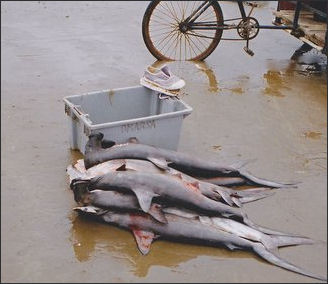
Hammerhead sharks in caught off Equador Shark and ray populations around the world plummeted a "staggering" 71.8 percent between 1970 and 2018 according to study published the journal Nature in January 2021. The study said three-quarters of shark species are threatened with extinction, and the true collapse is likely even worse than their findings. “Researchers hope the study serves as an "urgent wake-up call"...Knowing that this is a global figure, the findings are stark," co-author Nick Dulvy said in a news release. "If we don't do anything, it will be too late. It's much worse than other animal populations we've been looking at." [Source: Sophie Lewis, CBS News, January 29, 2021]
CBS News reported: “Out of a total of 31 species of oceanic sharks and rays, 24 are now threatened with extinction, and many are classified as critically endangered. “It's an incredible rate of decline steeper than most elephant and rhino declines, and those animals are iconic in driving conservation efforts on land," Dulvy said.
To measure the decline, researchers used two well-established indicators: the Living Planet Index, which measures changes in population abundance, and the Red List Index, which measures extinction risk. While human disturbances and climate change are among the factors considered in the study, researchers said that overfishing was found to be the greatest threat.
“Fishing of oceangoing sharks and rays has increased 1,800 percent since 1970, according to the study, with an estimated 63 million to 273 million sharks killed each year in the early 2000s. They are fished for their meat, fins, fill plates and liver oil — shark fin soup is considered a status symbol in some parts of Asia. “We can see the alarming consequences of overfishing in the ocean through the dramatic declines of some of its most iconic inhabitants," said lead author Nathan Pacoureau. Low population growth rates make it especially difficult for sharks to bounce back from over-exploitation. But, scientists say that conservation can still work if implemented properly.
The study urged lawmakers to act immediately to "prevent shark population collapses" — which would be devastating for both the health of marine ecosystems and the food security of people around the world. As top predators in the ocean, sharks help maintain balance of the food chain and they also boost the health of seagrass beds and coral reefs. “Thus far, overfishing has "far outpaced' any changes in fisheries management, trade regulations or conservation efforts. International cooperation is needed to make true progress "before depletion reaches a point of no return," researchers said. “It's something policymakers can no longer ignore," Pacoureau said. "Countries should work toward new international shark and ray protections, but can start immediately by fulfilling the obligations already agreed internationally."
“Conservation efforts have already shown some promise, but need to be implemented on a much larger scale. “Our analysis is generally grim, but there is hope to be found in a few shark conservation success stories," Sonja Fordham, President of Shark Advocates International, said in a statement. "We document rebuilding for several Northwest Atlantic species, including Great White Sharks and Hammerheads, achieved through science-based fishing limits. Relatively simple safeguards can help to save sharks and rays, but time is running out." “We urgently need conservation action across the globe to prevent myriad negative consequences and secure a brighter future for these extraordinary, irreplaceable animals."
More Than a Third of Shark Species Threatened
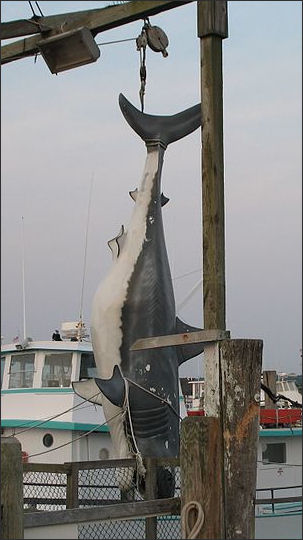
Great white caught off Montauk In 2014, the World Conservation Congress deemed around a third of the world’s shark species as threatened, but by 2021 the number had risen to 37 percent, due to pressures from fishing for meat and fins, climate change and pollution. "The alarm bells couldn't be ringing louder for sharks and rays," said Dr Andy Cornish, shark programme leader at the conservation group, WWF. "We are losing this ancient group of creatures — starting to lose it species by species right here, right now — we desperately need urgent action." [Source: Helen Briggs — BBC science and environment correspondent, September 4, 2021]
Decline of Large Sharks & Rays (More than 16.4 feet)
Great hammerhead shark 13 percent loss over 39 years
White shark 37 percent loss over 42 years
Common thresher shark 60 percent loss over 32 years
[Source: Mónica Serrano and Sean McNaughton, National Geographic, July 15, 2021]
Decline of Medium-Size Sharks (8.2-16 feet)
Smooth hammerhead shark 29 percent gain over47 years. Smooth hammerheads are a2 rebounding in areas with protections, such as the northwest Atlantic and Gulf of Mexico.
Pelagic thresher shark 62 percent loss over 35 years
Silky shark 63 percent loss over 25 years
Dusky shark 72 percent loss over 45 years
Oceanic whitetip shark 75 percent loss over 24 years
Porbeagle shark 15 percent loss over 45 years
Blue shark 29 percent loss over 46 years
Shortfin mako shark 38 percent loss over 48 years
The number of threaten species has risen quickly and sharply. According to the World Conservation Union, 16 percent of the 328 shark species it surveyed in the 2000s were threatened with extinction. Some European sharks are already commercially extinct. The population of once common Atlantic species have shrunken by 80 percent or more. In March 2007, a team of U.S. and Canadian scientists led by by Julia Baum of Dalhousie University calculated that between 1970s and 2005, the number of scalloped hammerheads and tiger sharks caught off the northeast coast of the United States shrunk by more than 97 percent and that the population of bull, dusky and smooth hammerhead sharks had dropped by more than 99 percent. The silky white tip shark has disappear from the Caribbean.
Of the 21 species found in the Atlantic, three-quarters are classified as threatened with extinction. North Atlantic populations of the oceanic white tip, for example, have declined by 70 percent, and hammerheads by more than 99 percent, according to the International Union for the Conservation of Nature (IUCN). Other species — including the porbeagle, common thresher and shortfin mako — have also been overexploited, and may be teetering on the brink of viability.
100 Million Sharks Killed Every Year, Study Says
An estimated 100 million sharks are killed every year around the world, a number that far exceeds what many populations need to recover, according to a statistical report, compiled by researchers at Dalhousie University. The study took in data from form reported shark catches globally and used data from nearly 100 former papers to estimate the number of unreported shark deaths every year. In doing that the researchers calculated that between 6.4 percent and 7.9 percent of sharks of all species are killed annually.[Source: National Geographic, March 2, 2013]
According to National Geographic: To put that range in perspective, researchers analyzed life data from 62 shark species and found that only 4.9 percent of sharks can be killed each year to maintain population stability. Anything more than that threatens long term survival of species like the oceanic white tip, porbeagle and several kinds of hammerheads. What’s worse, sharks are considered uniquely vulnerable because they take long periods to mature and generally produce few young over their lifetimes.
The culprit is the proliferation of illegal shark finning that spiked in the 1990s to feed appetites for shark fin soup. While some sharks are allowed to be caught, illegal shark finning occurs when fisherman cut fins off live sharks and dump their bodies into the open ocean to avoid declaring the full animal at port and surpassing fishing quotas. In the 2000s, An estimated 26 million to 73 million sharks are killed every year for their fins, which are used to make shark fin soup.
“There’s a staggering number of sharks being caught every year and the number is way too high considering the biology of species,” says Dalhousie biologist Boris Worm, the study’s lead researcher. The 100 million sharks was actually a conservative estimate. Worm’s team found the number could be as high as 273 million sharks killed each year.
Shark Finning and the Cruel, Lucrative Shark Fin Trade
More than 70 million sharks were killed in 2012, largely to satisfy demand for their fins, which are used to make shark fin soup. Most of these sharks are “finned” — their fins are sliced off while the sharks are still alive — then dumped back into the ocean to drown or bleed to death. The number of sharks taken solely for their fins increased 2,000 percent between 1990 and 2000 and has continued soaring since then. In addition catching sharks for shark fin soup is often very cruel. Finning continues being banned in roughly one-third of countries where it is practiced, according to the Pew Environment Group.
Because the fins are so valuable and the meat isn't, the fins of captured sharks are often lopped off and still-alive sharks are thrown back in the water where they die a slow agonizing death. The practice is prohibited, but loopholes in the regulation have allowed the ban to be widely ignored.
The trade in shark fins is extremely profitable. Shark fins are easy for fishermen to transport and preserve by sun drying. In 2007, Mexican fishermen were pad $100 per kilogram for dried fins they delivered. In contrast they were paid less than $1.50 a kilogram for the shark meat. Middle men are able to sell quality shark fins to restaurants for up to $2,350 a kilogram. Soups made with these fins sell for a much as $250 a bowl.
See Separate Article SHARK FIN SOUP AND TRYING TO STOP CONSUMPTION OF IT ioa.factsanddetails.com
Shark Fishing

Whale shark recovered from shallow water It is estimated that worldwide 26 to 76 million sharks are killed every year while sharks on average kill two to eight people annually. Some sharks are taken for food. Others are taken accidentally in nets or with longlines and regarded as waste. These days many are caught for their fins. Until recently shark meat was considered worthless and most fishermen threw sharks that drifted into their nets back into the sea dead.
Shark fishing began in earnest after World War II when sharks were caught for their liver oil, which is rich in Vitamin A. About 856,000 tons of sharks and rays were caught in 2003, up from 760,000 tons caught in 1997 and that was up from 272,000 tons in 1950.
Many sharks are snagged accidentally by fishermen seeking other fish such as tuna and swordfish. Every year 50,000 blue sharks are caught accidentally off Hawaii alone and striped of the fins and thrown back. During a six month period in 1989, Japanese squid boats snagged 58,100 blue sharks in their drift nets.
The main shark fishing nations include Argentina, Brazil, Britain, France, India, Indonesia, Italy, Japan, Malaysia, the Maldives, Mexico, New Zealand, Pakistan, Portugal, South Korea, Spain, Sri Lanka, Taiwan and the United States.
After the film “ Jaws” came out in the the 1970s "monster fishing" became all the rage and shark tournaments were held with $60,000 first prizes. Nowadays, most shark fishing is of the catch-and-release variety.
Shark Fishing off Senegal
Drew Hinshaw of the New York Times wrote: “While his children slept on the sand during the final hour before daybreak, Pathé Ndong packed a canister of diesel and an icebox full of knives for the day ahead. In Mbour, a shantytown on Senegal’s Atlantic coast, everyone is a fisherman in disguise, including this father of nine. On mornings like this one, the carpenter becomes a knife-wielding Ahab. When I asked Ndong what he was out to catch, his 43-year-old eyes flared. “Gainde guedj,” he said in Wolof. The lion of the sea. [Source: Drew Hinshaw, New York Times, December 16, 2011]
Of the tens of millions of sharks killed each year, an oddly disproportionate number are caught by scrappy Senegalese fishermen like Ndong. One out of every 100 sharks reported caught between 2000 and 2008 was killed off the coast of Senegal, a country about the size of South Dakota.
Though departing Air France passengers routinely complain about the stench wafting from the planes’ baggage holds — up to 1,300 pounds of fins a week — the fishermen smell only money. A single adult shark fin can fetch $80, while a whole, two-meter monster can bring in $300. It’s a fantastic sum in this beach town with its iffy electricity or anywhere in the country. Twenty-seven percent of Senegalese men also happen to be 15 to 19 years old. And because many can’t read, can’t afford to leave and can’t find work in Mbour’s hotels, they go into the only other industry around, no matter how dangerous.
As Ndong walked by a crab-organ-littered fish market, he dropped his equipment into his 15-foot boat and steered it out to sea, zigzagging around dozens of other departing pirogues — all handpainted with names of wives and daughters and mystic symbols like eyeballs. Fishermen around the world have developed various ways to kill sharks. Ghanaians often use nets. In Papua New Guinea, some fishermen lasso them up with rope, like cowboys. In Senegal, though, they club them to death.
At the beach, I asked Ndong’s colleague, Fara Ndiaye, for a demonstration. Ndiaye couldn’t find the words in French, our common language, so he playacted instead. First, as the finger in his cheek illustrated, you hook a shark by its gills. And the animal, as his arms elaborated, could be five feet long. Then, somewhat abruptly, Ndiaye pulled a footlong plank out from a nearby pirogue and viciously hammered the imaginary shark on its head. Thwack, thwack, thwack. “Tu comprends?” he asked.
By daybreak, Ndong was setting up his traps on the water. He took 200 fingerling baitfish and jabbed them on 200 rusted hooks. Then he draped the kilometer-long fishing line into a spot of ocean not far from the coast. As Ndong played out his last stretch of line, he picked up a carp and beat it against the hull of his boat. Fish guts spilled into the water. He stirred it up like sugar into tea. “More blood and they’ll want to come eat,” he said. Days later, a more masochistic fisherman, Modou Mbaye, cut his left thumb with a piece of plastic and dipped his hand into the shark-infested waters. It was his variation on the method.
These days, amateur Senegalese fishermen have to be inventive. The schools of sharks that once swam off the country’s shore have declined drastically, said Birima Fall, a researcher for the World Wildlife Federation. The steady migration of fishermen confirms this. In the early 2000s, Senegal’s shark industry centered on St. Louis, a port near the Sahara, but that town’s shark-oil refinery has since closed, and the shark-fishing fleets now converge in Guinea-Bissau, a nation 250 miles south. “One day, we’ll find them in Cape Town,” Raoul Monsembula, a Greenpeace biologist, said, only half-jokingly.
By noon, Ndong’s most valuable catch was a log that seemed to have fallen overboard from one of the many other pirogues. He was ready to return empty-handed when his line snagged a pair of the ocean’s next-most-prized deadly catch, two stingrays. Out on the water, Ndong looked delighted as he harpooned the rays and clubbed their heads. The meat, he assured me, could be deep-fried. “If I could just catch sharks and stingrays, that would be good,” Ndong said. The next day, he caught four more stingrays. “The stingray is attempting to replace the shark,” Oumy Sène Diouf, a Greenpeace researcher, said later. Second-tier predators like stingrays are flourishing in place of the sharks, and because fishermen are catching fewer sharks, they’ve turned to stingrays out of necessity, at least for now. “What happened to the sharks,” Diouf said, “is going to happen to the stingray.”
Consequences of Shark Fishing
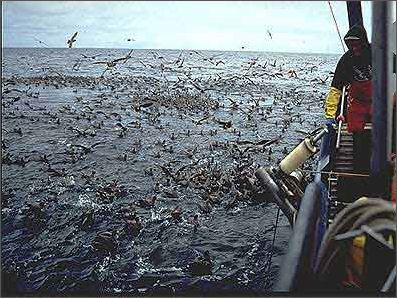
longliners like this often snag sharks Shark fishermen tend to target pregnant females because they are more profitable as they are larger. A study by Nicholas K Dulvy of Simon Fraser University in British Columbia found in the open ocean sharks such as threshers, ocean white tips and shorftfin mako sharks that were once hooked as bycatch by vessels seeking tuna and swordfish are being pursued as primarily catch for their fins.
Reporting from waters off of Narragansett, Rhode Island, Glenn Hodges wrote in National Geographic: “As we hauled yet another blue shark to the side of the boat, I finally took note of the obvious. “It seems like all the blue sharks have hooks in their mouths,” I said. Brad Wetherbee, the marine ecologist from the University of Rhode Island who was there to tag any makos we caught, said, “Yup. Every one we’ve brought back to the boat so far has had a hook in it.” [Source: Glenn Hodges, National Geographic, August 2017]
“Removing a hook from a shark’s mouth can be dangerous, so fishermen just cut the leaders and leave the hooks to rust away. And because the fishermen are after makos, they’re much more likely to release blue sharks. “I’ve never seen a mako with a hook,” the ship’s mate, Lucas Berg, told me our first day out. “People don’t ever let them go. But we’ve caught blue sharks with four hooks in their mouth.”
Shark Overfishing
Researchers estimate that 100 million sharks are killed each year, some 73 million of them for the lucrative trade in shark fins. As demand, mainly from China, has soared, many shark populations have plummeted by as much as 90 percent in recent decades. If sharks continue to be overfished at the current rate, it’s only a matter of a few years before the targeted species are extinct, according to Richard Thomas, communications director at Traffic, which monitors wildlife trade. [Source: Bettina Wassener, New York Times, June 20 2010]
University of Miami shark biologist Samuel Gruber has said that if all the bodies of all the sharks killed every year were stacked into a pile, they would weigh more than a billion pounds. If the dead sharks were placed nose to nose, he said, they would circle the earth five times. [Source: Sy Montgomery, July/August 1992, International Wildlife]
Shark fisheries in Nigeria, Nicaragua, Mexico and the Arabian Sea have collapsed from overfishing, Montgomery says. There are no hammerheads off of Costa Rica anymore. Australia now has limits on fishing license given out and restriction on the gear that fishermen can use so that they don't loose all of their "whitey's."
Consequences of Shark Overfishing on Reefs and Other Species
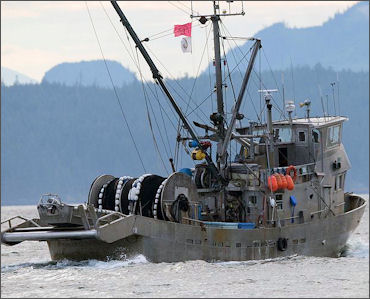
Drum net seiners also catch sharks Overfishing of sharks off the northeast coast of the United States has not only hurt the sharks but also threatens other species such as scallops, shrimps and crabs as populations of rays and skates that have traditionally been the prey of sharks have exploded and are gobbling up scallops, shrimps and crabs. In Alaska the pollack catch has suffered as sleeper sharks — that preyed on seals that eat pollack — have been overfished. Shark overfishing off of Australia and Tasmania several years ago caused an overpopulation of octopuses and a dramatic drop spiny lobster population.
The decline of coastal shark numbers has led to an increases in species such as the cownose ray that sharks have traditionally feed on. Julia Baum of Dalhousie University, author of a April 2007 article on the shark overfishing published in Science, told Reuters, “With fewer sharks around, the species they prey on — like cownose rays — have increased in numbers, and in turn, hordes of cownose rays dinning on bay scallops have wiped the scallops out.” The overfishing of fish that sharks traditionally preyed upon has hurt sharks by giving them less to eat. We are also seeing more sharks caught deliberately for their meat as the decline of popular food species has led to sharks being harvest food as food. To help the environment some have suggested killing the rays rather than trying to help the sharks recover.
Overfishing of sharks endangers reefs according to an Australian study. AFP reported: Scientists studying reefs off Australia said sharks play a fundamental role in the health of coral, and overfishing of them made reefs more vulnerable to global warming and weather disasters. A research team, led by Mark Meekan from the Australian Institute of Marine Science (AIMS), studied the impact of sharks at the Rowley Shoals and Scott Reefs 300 kilometers (185 miles) off northwest Australia over 10 years. [Source: Agence France-Presse, September 19, 2013]
"Where shark numbers are reduced we see a fundamental change in the structure of food chains on reefs," said Meekan. "We see increasing numbers of mid-level predators such as snappers, and a reduction in the numbers of herbivores such as parrot fishes. "The parrot fishes are very important because they eat the algae that would otherwise overwhelm young corals on reefs recovering from natural disturbances." When coral dies algae grows over it, compromising its ability to regrow. Meekan said the herbivorous fishes chewed out small spaces so regrowth could take place. The study compared the impact of cyclones and bleaching events on the marine-protected Rowley Shoals, where fishing is banned, with the neighbouring Scott Reefs, where Indonesian fishermen — mostly from West Timor — are allowed to catch sharks.
Efforts to Save Sharks
Conservation efforts include clamping down on fishing and protecting breeding and pupping areas. In November 2004, more than 60 countries agreed to a ban of killing sharks for their fins in the Atlantic Ocean. Peter Benchley, the author of “Jaws”, of all people was a leader in the effort to save sharks until his death in 2006. In 2000, U.S. president Bill Clinton signed a bill that banned the practice of shark finning, making it illegal to possess a shark fin without a corresponding carcass. The bill only affects fishing in U.S. waters and U.S. fishermen. Many countries do not such laws and the American law is difficult to enforce.
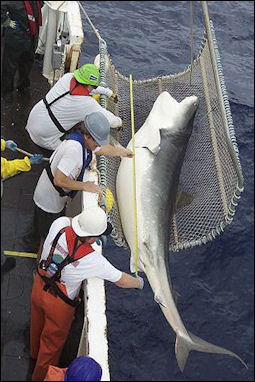
scientists studying a tiger shark Juliet Eilperin wrote in the Washington Post: Christopher Neff, a doctoral candidate at the University of Sydney who researches the human-shark relationship, said that humans are becoming more open to protecting sharks in the open ocean even as they're growing more hostile to those near shore. In March 2013, the Convention on International Trade in Endangered Species of Wild Flora and Fauna (Convention on International Trade in Endangered Species (CITES)) agreed to impose new rules on the trade in hammerhead, oceanic white tip and porbeagle sharks under which countries would have to prove their catch was sustainable before exporting it. Spiny dogfsh and porbeagle shark are two heavily fished shark species. Spiny dogfish is used in fish and chips. Porbeagles are prized for their meat and fins. Their numbers have plummeted 95 percent in the Northeast Atlantic Ocean, prompting the World Conservation Union, to label them as critically endangered. [Source: Juliet Eilperin, Washington Post, August 6, 2013]
Shark advocates have pressed the United Nations to adopt a strong management plan for sharks that would prohibit catching threatened or near-threatened shark species and end the practice of shark finning. In May 2007, Mexico, which has a large shark fishery, banned shark finning and passed laws that require authorities to monitor the activities of large shark-fishing boats. In 2009, Palau became the first country to ban shark fishing in its waters. Maldives followed in 2010, and this summer, Honduras and the Bahamas did the same. A group of governments in Micronesia — including Palau — recently agreed to create the world's largest shark sanctuary in the western Pacific Ocean, spanning more than 2 million square miles. That's equivalent to two-thirds of the land mass of the continental United States. In December 2012, French Polynesia and the Cook Islands joined together to create the world's largest shark sanctuary, emulating small island nations such as Palau and the Maldives in banning all shark fishing in their waters.
In the United States the National Marine Fisheries Service has imposed regulations on size, season and catch limits and set a quota of 2,436 metric tons for large coastal sharks in U.S. territorial waters. Many want to shark fishing banned completely Australia and Some countries in Africa also have shark management plans.
Oceana and several conservation groups, backed by some governments, have called upon ICCAT to set catch quotas and other protective measures for these and other vulnerable sharks. The United States has proposed requiring that all sharks be brought back to shore whole, which would boost enforcement of the finning ban and help scientists measure population levels. Japan — which quashed a drive earlier to protect four threatened shark species under the UN Convention on International Trade in Endangered Species (CITES) — is now urging ICCAT to prohibit fishing one of them, the oceanic white tip. The initiative "is an example showing our commitment for conservation of shark resources," the head of the Japanese delegation said in an opening statement.
Obstacles to Efforts to Save Sharks
Most countries have authority to regulate around their own coastlines and the catches brought into their ports. But pressure has grown over the past few years for the Conference on International Trade of Endangered Species (CITES) to regulate international trade of the most imperiled species. In 2010, CITES officials denied meaningful protections to sharks. In 2013, a United Nations panel recommended that governments get serious. [Source: National Geographic, March 2, 2013]
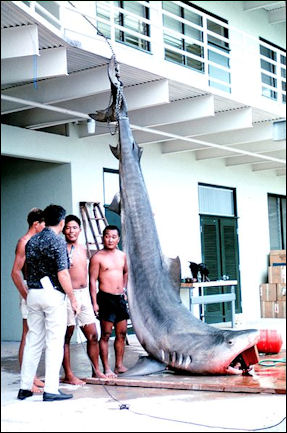
Tiger shark caught by
sport fishermen in Hawaii But both western Australia and Réunion have authorised shark hunts in the wake of deadly strikes there. Neff noted that researchers have become better at tracking sharks' swimming patterns with the use of satellite and radio tagging, but sharing this sort of information "can arouse public anxiety", and it can't prevent some of the inevitable human-shark interactions that arise.
Fishermen don’t like the restrictions and feel efforts to save sharks will put them out of business. Questions have been raised about how they rules will be enforced. Efforts to reign in in fishing are often ignored. What goes on out at sea is difficult to monitor and keeping an eye on all the fish brought ashore is no easy task either. Between May 2006 and April 2007, U.S. vessels caught 6.2 million pounds of the fish, exceeding quotas by more than 50 percent.
"Sharks are virtually unmanaged at the international level," said Elizabeth Griffin Wilson of Oceana. "ICCAT has a responsibility to protect our oceans' top predators."Under the UN Convention on the Law of the Sea, "highly migratory" sharks must be managed by international bodies.
Scott Henderson, who heads Conservation International's Eastern Tropical Pacific Seascape program and has worked in Latin America for two decades, said fishermen there are well aware of what's happening. "They know sharks are being caught in lower numbers, they know they have to go further out and spend more effort catching them. They know what that means."
Legislation to Protect Sharks Voted Down in 2010
In March 2010, delegates to a United Nations conference on endangered species voted down three of four proposals to protect sharks, handing another victory to Japan, China and countries opposed to the involvement of the international authorities in regulation of ocean fish. The nations gathered in Doha, Qatar, for the Convention on International Trade in Endangered Species of Wild Fauna and Flora, rejected proposals that would have required countries to strictly regulate — but not ban — trade in several species of scalloped hammerhead, oceanic whitetip and spiny dogfish sharks. [Source: David Jolly, New York Times, March 23, 2010]
The hammerhead and whitetip proposals, introduced by the United States and the tiny Micronesian island of Palau, received majority backing. But the treaty behind the conference, abbreviated as Cites, requires that measures be approved by two-thirds of the delegates who are voting.
A proposal from the European Union and Palau to protect porbeagle sharks squeaked by with a vote of 86 to 42, with 8 abstentions — a winning margin of a single vote. All of the votes were by secret ballot.
“We will continue to pursue our efforts to protect sharks from eradication by the decadent and cruel process of shark-finning,” Stuart Beck, Palau’s ambassador to the United Nations, said in a statement. “I am sure that, properly prepared, bald eagle is delicious. But, as civilized people, we simply do not eat it.”
China, by far the world’s largest consumer of the cartilaginous fish, for sharkfin soup, and Japan, which has battled to keep the convention from being extended to any marine species, led the opposition. “This is not about trade issues, but fisheries enforcement,” Masanori Miyahara, Japan’s top fisheries negotiator, was quoted by The Associated Press as telling delegates. “Poaching is a big problem.”
Shark Victims Rally Behind the Species
John Collins Rudolf wrote in the New York Times, “Debbie Salamone has every reason to hold a grudge against sharks. In 2004, she was swimming at a beach in Florida when a shark bit down on her foot, severing her Achilles tendon. Paul De Gelder, an Australian Navy diver who lost a hand and leg to a shark attack, is in New York City this week to advocate for shark conservation. Pew Environment Group Paul De Gelder, an Australian Navy diver who lost a hand and leg to a shark attack, is in New York City to advocate for shark conservation. [Source: John Collins Rudolf, New York Times, September 13, 2011]
In September 2011 these three and seven other shark attack survivors from six countries petitioned the United Nations to protect the very species that tried to make a meal out of her. “I figured, who better to speak up for sharks than me and people like me,” told Ms. Salomone, who organized the unusual campaign while working for the nonprofit Pew Environment Group, told the New York Times. “It’s a great story of irony and forgiveness.” Salomone was a dancer who recovered enough from her injury to dance again.
The effort was part of a larger campaign by ocean conservation groups, including Pew, urging the United Nations to strengthen protections for shark species worldwide. Several voluntary national and international agreements exist that set guidelines for the management of shark populations, but these agreements have been largely ineffective in stemming shark overfishing.
Recruiting the shark victims to advocate for their attackers was easier than she expected, Ms. Salamone said. “Most people were very eager to participate,” she said. “There were only a couple who weren’t ready to go there yet.” Gelder, 33, a Navy diver from Sydney, Australia, lost his right hand and right lower leg in an attack last year during anti-terrorism exercises. Other victims include a lifeguard whose foot was bitten off during rescue practice, and a surf photographer who lost a leg to a tiger shark and continues to surf using a prosthetic leg.
Image Sources: Wikimedia Commons, NOAA
Text Sources: Mostly National Geographic articles. Also the New York Times, Washington Post, Los Angeles Times, Smithsonian magazine, Natural History magazine, Discover magazine, Times of London, The New Yorker, Time, Newsweek, Reuters, AP, AFP, Lonely Planet Guides, Compton’s Encyclopedia and various books and other publications.
Last updated March 2023

